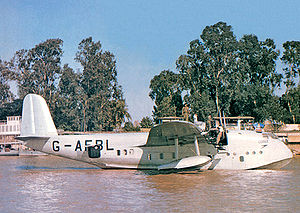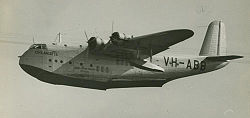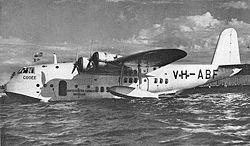Short Empire Video - Overview - Drawings, pictures
|
|
Short Empire
Empire

Picture - The BOAC Short 'C' Class flying boat G-AFBL Cooee, at Rod El Faray, Egypt, c. 1942
Role: Flying boat mail carrier
Manufacturer: Short Brothers
First flight: 3 July 1936
Primary user: Imperial Airways
Number built: 42
The Short Empire was a passenger and mail carrying flying boat, of the 1930s and 1940s, that flew between Britain and British colonies in Africa, Asia and Australia. It was manufactured by Short Brothers and was the precursor to the more famous Short Sunderland of World War II.
Design and development
The origins of the Empire boats lay in an Air Ministry requirement for passenger and mail carriers that could service the colonies particularly to make the connection to Australia.
The Empire was officially known as the C-class and each aircraft was christened with a name beginning with C. The first aircraft, G-ADHL Canopus, was completed in June 1936 and launched on 3 July. A total of 42 Empires were built, all at Short's Rochester factory.
Imperial Airways (and its successor BOAC), Qantas and TEAL operated the Short Empire.
The first series of the Short Empires, the S.23, could carry 5 crew, 17 passengers, and 4,480 lb (2,035 kg) of cargo at a maximum speed of 174 knots (320 km/h).
The Short Empire was designed to operate along the Imperial Airways routes to South Africa and Australia, where no leg was much over 500 miles. After the design was finalized and production was started it was realized, with some pressure from the US, that it would be desirable to offer a similar service across the Atlantic. The range of the S.23 was less than that of the equivalent US Sikorsky "Clipper" flying boats and as such they could not provide a true trans-Atlantic service. Two boats (Caledonia and Cambria) were lightened and given long range tanks and experimented with in flight refuelling so they could make the trip but that meant they could carry fewer passengers and cargo. In an attempt to manage the Altantic crossing a piggy-back approach was tried. Using a similar, the S.21, design as the main carrier and a smaller four-engined floatplane design, the Short S.20, mounted on its back. Only a single example was built of a carrier aircraft, the S.21 (known as Maia) and one S.20 (Mercury) together known as the Short Mayo Composite. A successful mid-air launch of Mercury was made in 1938, and it was to set a number of long distance records however a launch aircraft was required for both sides of the Atlantic and it was limited to carrying mail, and no further development of this concept occurred in the UK.
The S.30 series were fitted with the slightly more efficient, but lower powered 815 hp Bristol Perseus sleeve valve engines and had a strengthened airframe allowing the take off weight to be increased to 46,000 pounds and giving a range of 1,500 miles. Cabot, Caribou, Clyde and Connemara were fitted with in-flight refuelling equipment and extra fuel tanks so they could be used for a regular trans-atlantic airmail service. The idea behind this was for the aircraft to take off and once airborne take on extra fuel to an all up weight of 53,000 pounds giving a range of over 2,500 miles. The extra fuel did reduce the payload to 4,270 pounds against the 6,250 pounds of the standard craft. The refuelling was by three converted Handley Page Harrow bombers, one operating out of Ireland and two out of Newfoundland. The S.33 was a further follow-on to the S.30 with a later version of the Pegasus to what had been fitted to the S.23
While originally deemed unable to takeoff with sufficient fuel, wartime experiences at operating in overload resulted in the realization that the Empires could be flown at considerably higher weights than the very conservative estimates provided by Shorts and by late in the war were flying across the Atlantic without resorting to in-flight refuelling, and while still carrying a reasonable cargo.
In addition to the C class flying boats there were also three S.26 type built; these were known as the "G class" and had names starting with "G": Golden Hind, Golden Fleece and Golden Horn. They were considerably larger than the C class and benefited from improvements to hull design made after the finalization of the S.23 design but aside from a general resemblance were an entirely new design which had been intended for provide a regular trans-Atlantic service. They had a wing span of 134 ft (40.9 m) and a length of 101 ft. (30.9 m).
Variants

Picture - Qantas Short C Class Empire flying boat VH-ABB 'Coolangatta', ca. 1940
S.23 : Passenger and mail flying-boat, powered by four 920-hp (686-kW) Bristol Perseus radial piston engines. 31 built.
S.23M : Two S.23's were fitted with an ASV radar, and armed with guns and bombs.
S.26 'G' Class Empire Passenger and mail flying-boat. Three built.
S.26M 'G' Class armed VIP transport, modified from S.26.
S.30 : Passenger and mail flying-boat, powered by four 890-hp (664-kW) Bristol Perseus radial piston engines, Derivative of S.23. Nine built.
S.33 : Passenger and mail flying-boat, powered by four 920-hp (686-kW) Bristol Perseus radial piston engines. Derivative of S.23. Two built.
Service
In 1937 Caledonia was flown experimentally from Foynes on the River Shannon west to Newfoundland while an American Sikorsky S-42 flew the opposite direction. Caledonia took just over 15 hours (including a period looking for landing spot) flying at an altitude of 1,500 to 5,000 ft (460 to 1,500 m) to cover 1,993 miles (3,207 km) - an average speed of about 130 mph (0.058 km). The Sikorsky took about half an hour less on flying at 10,000 ft (3,000 m).
During the Second World War the UK-Australia route was stopped and a new route was established which ran from Sydney to Durban via Cairo. This was stopped after the loss of Singapore but restarted when the Japanese were ousted from Burma and Malaya.
List of aircraft
Operators

Picture - Short S.23 Cooee of Qantas - this aircraft is also pictured at the top of the page while later serving with BOAC
Civil Operators
Australia
Qantas
New Zealand
TEAL
United Kingdom
Imperial Airways
BOAC
Military Operators
Australia
Royal Australian Air Force
No. 11 Squadron RAAF
No. 13 Squadron RAAF
No. 20 Squadron RAAF
No. 33 Squadron RAAF
No. 41 Squadron RAAF
United Kingdom
Royal Air Force
No. 119 Squadron RAF
Specifications (Shorts S.23)
Data from The Encyclopedia of World Aircraft
General characteristics
Length: 88 ft (26.82m)
Wingspan: 114 ft (34.75 m)
Height: 31 ft 9¾ in (9.70 m)
Wing area: 1,500 ft² (139.35 m²)
Empty weight: 23,500 lb (10,659 kg)
Max takeoff weight: 40,500 lb (18,370 kg)
Powerplant: 4x— Bristol Pegasus radial engines, 920 hp (696 kW) each
Performance
Maximum speed: 200 mph (322 km/h)
Range: 760 miles (1,223 km)
Service ceiling: 20,000 ft (6,100 m)
Related development
Short S.26
Short Mayo Composite
Comparable aircraft
Boeing 314
Sikorsky VS-44
BOAC At War - Part 2 - Aeroplane Monthly - August 1975
Sims, Phillip, Adventurous Empires. Airlife Publishing, 2000. ISBN 1-84037-130-7
Vector site development of Sunderland through Empire boats
Barnes C.H. & James D.N. Shorts Aircraft since 1900. London (1989): Putnam. pp. 560. ISBN 0-85177-819-4.
Short Empire Pictures
Living Warbirds: The best warbirds DVD series.
Source: WikiPedia